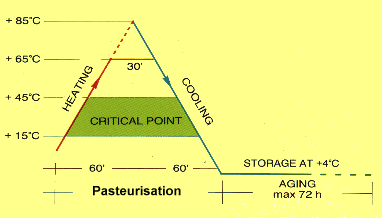 |
HIGH
PASTEURISATION: Heating up to +85°C and quick cooling up to +4°C LOW PASTEURISATION: INTERMEDIATE
PASTEURISATION: CRITICAL POINT: |
In 1864, while examining fermentation of wines, vinegars, beers and milk Louis Pasteur, the famous French scientist, discovered that some micro-organisms were the caused of it. This was the beginning of pathogenous microbes study and the realisation of the fact that any infectious disease derived from a specific microbe. Pasteur ascertained that milk boiling to over +100°C destroyed all pathogenous microbes but this also reduced nourishing values of milk itself. By carrying on his experimentation he ascertained that boiling milk up to +65°C, keeping it for 30 minutes at this temperature and then lowering it to +4°C destroyed all pathogenous microbes, while the remaining nourishing and structural features of milk were left unchanged. Experimentally, Pasteur realised a complete CONTROLLED THERMAL TREATMENT that could improve some foods, without spoiling vitamins and proteins.
This process, called PASTEURISATION, is
essential to the ice-cream mix treatment.
For an effective improvement of ice-cream mix, it is important
that all ingredients are subjected to the thermal treatment for a
certain time and are then quickly cooled down while covered from
any possible new pollution. This why you must absolutely avoid
any hypothetic overheating and subsequent cooling into a freezer.
It is found that:
So the pasteurisation of ice cream mix must not be carried out empirically, but following a sequence of temperatures and times critical to the process.
 |
HIGH
PASTEURISATION: Heating up to +85°C and quick cooling up to +4°C LOW PASTEURISATION: INTERMEDIATE
PASTEURISATION: CRITICAL POINT: |
The Aging Process
In order to get first-rate quality ice cream, the mixture must be adequately aged after the pasteurisation process.
Mix aging occurs while at rest in storage at +4°C. The aging process enables the hydration of proteins, stabilisers and remaining solids which in turn reduces the comes free water within the mixture to a minimum. Such a deep hydration is essential in order to obtain a fine and palatable ice cream structure. Reducing water contents to a minimum avoids big ice crystals from being formed which would give ice cream a rough structure. During ageing, the smallest particles of fat improve the property of the mixture keeping air. This will allow the ice cream to be much more creamy in texture and will lead to some 11% to 12% overrun. By a good ageing process ice cream melting will slacken significantly and its resistance to thermal changes will improve.